The Hydration Patch enables caregivers to monitor senior hydration levels in real-time through advanced, non-invasive sweat analysis.
Hydration Check Patch
In response to an aging population in Europe and the increasing need for diagnostic tools to empower patients, the Hydration Check Patch offers a non-invasive solution for continuous hydration monitoring. Utilising electrochemical sweat analysis, the patch enables up to three days of monitoring without the need for physical activity. The patch is designed for elderly individuals in various care settings. It includes a rechargeable transmission pod that processes and transmits critical electrolyte data to an accessible and reduced interface smartphone application. Designed in two dressing shapes, the patch supports both self-application and caregiver-assisted scenarios. This project aims to support caregivers by addressing the rising demands of care, staff shortages, and the increasing frequency of heatwaves due to climate change.
Project Information
As a response to Europe’s aging population and the increasing need for diagnostic tools that empower patients, I developed the Hydration Check Patch during my thesis project. My objective was to combine my interest in new technologies with a thorough design process, identifying an emergent technology and transforming it into a relevant product offering for a vulnerable user group. In this case, non-invasive biomarker analysis with sweat stood out as a pain-free alternative to blood drawing that can provide insights into a range of important biomarkers.
During my research, I explored demographic aging and the rising strain on healthcare systems across Europe. By 2025, an estimated 29% of Europeans will be aged over 65, significantly increasing healthcare needs amidst stagnant healthcare capacities due to an already existing shortage of qualified healthcare personnel. This situation underscores the urgent need for diagnostic and preventive tools, as well as remote healthcare applications that empower patients to take responsibility for their health.
Looking at the product offerings on the market today, I identified a gap for sweat analysis solutions tailored as a tool for healthcare professionals. A low number of existing products primarily target fitness enthusiasts and athletes for performance tracking. My goal was to adapt this technology for hydration monitoring in older individuals, whether they live independently, receive assisted home care, or reside in stationary care settings.
Methods
To gain a better understanding of sweat sensing technology, I read into current developments and future projections based on research publications. I conducted interviews with experts across various disciplines, including elderly care professionals in Germany, medical experts experienced with ambulant care patients, and industry professionals for the production of wearable biosensors. An important part of my research was a field trip to Oulu, Finland, where I visited VTT, a leading research organization in printed electronics and diagnostic biosensors. The insights from these experts were invaluable, helping me iterate on my prototypes to meet both healthcare professional demands and production requirements.
Since the product is designed for close contact with the body, understanding the materials was crucial. Early in the process, I conducted material experiments with textiles, knits, plastic foils, films, and silicone to integrate these soft materials into my iterative prototyping process.
Result
The Hydration Check Patch is a non-invasive device for continuous hydration monitoring through electrochemical sweat analysis. It uses iontophoresis technology to induce sweat locally, allowing for continuous monitoring for up to three days without physical activity. The patch is adaptable to any upper body location, making it suitable for older individuals in both stationary and home care settings. It includes a rechargeable transmission pod that processes and transmits data on essential electrolytes—sodium, potassium, chloride, and lactate—to a smartphone application.
The patch was designed in two dressing shapes: a smaller, less visible version for self-application by older individuals and a larger version with extended pull tabs for caregiver application. The larger patch ensures stable adhesion on areas such as the side abdomen, neck, or back, enhancing versatility across various care environments. The electrochemical sweat analysis system on the back of the patch maintains close contact with the skin. Iontophoresis cathodes and anodes stimulate sweat glands with a 1 milliamp current, imperceptible to the wearer. The generated sweat is drawn into a microfluidic channel by capillary action, passing through six molecularly imprinted polymer (MIP) sensors that measure sodium, potassium, chlorine, and lactate levels in real-time. The transmission pod's pins connect to silver electrodes, where signals are filtered and analyzed by algorithms before being sent to the smartphone application. The sensor array is produced cost-effectively with roll-to-roll printing processes, as demonstrated by research teams at Caltech and Berkeley University.
The Hydration Check Patch is optimized for both home and stationary care settings, serving as an innovative documentation and monitoring tool for caregivers. It includes a dedicated application for healthcare professionals, seamlessly integrating with existing care documentation systems to provide detailed insights into hydration levels, electrolyte balance, and temperature measurements.
The Hydration Check interface uses a minimalistic graphical element, representing hydration levels together with three distinct colors with gradients to indicate hydration states, and concise textual prompts. This design facilitates accurate hydration monitoring, empowering both elderly individuals and their caregivers to manage health more effectively, especially with the expected rise of heatwaves across Europe due to climate change.
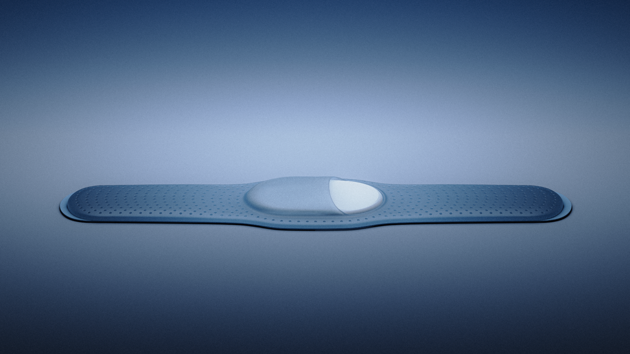
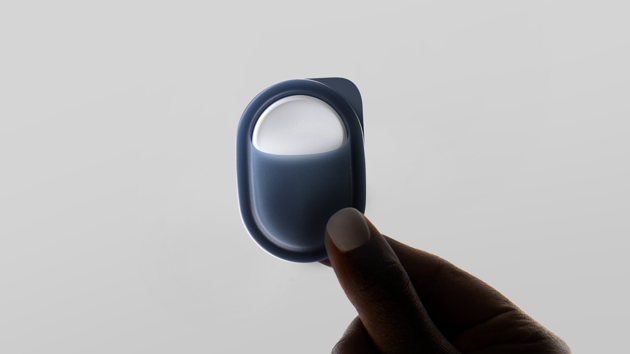
The patch is designed for two scenarios: a discreet form factor for self-application and an optimized dressing for application by a caregiver.
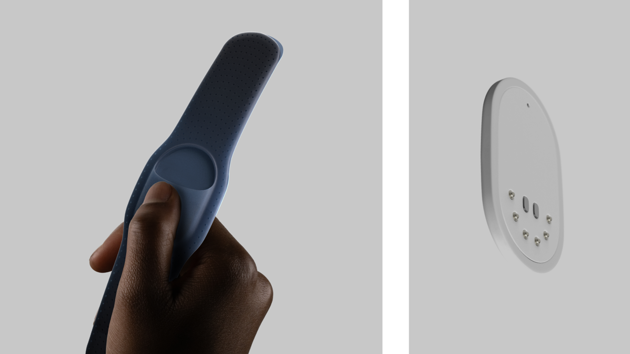
The Hydration Check Patch’s sleeve design reduces material waste on single-use parts compared to existing products.
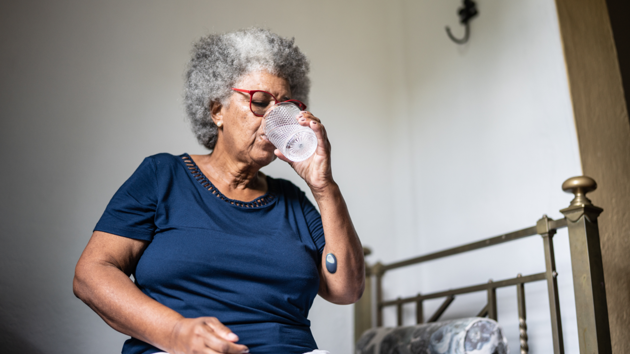
The device has been developed to support senior individuals with a decreased sense of thirst in staying hydrated.
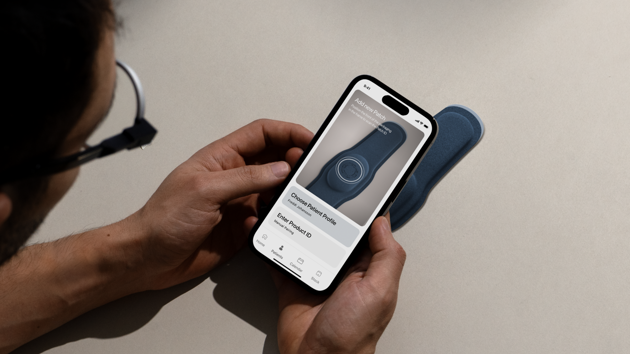
Caregivers can pair and manage multiple patches in a separate app by scanning the packaging, connecting a pod via NFC, and assigning it to a user profile.
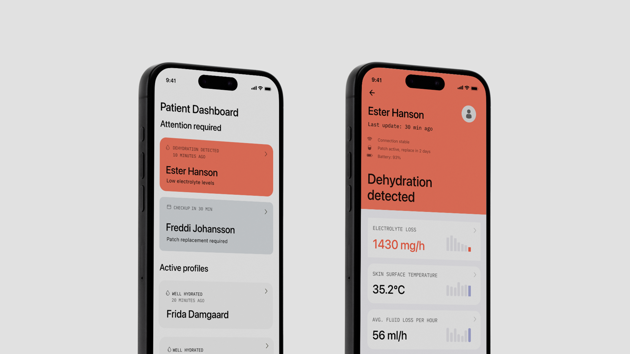
Caregivers use a separate app to monitor multiple patients and key health data, like electrolyte levels. This data can connect to existing care documentation systems.
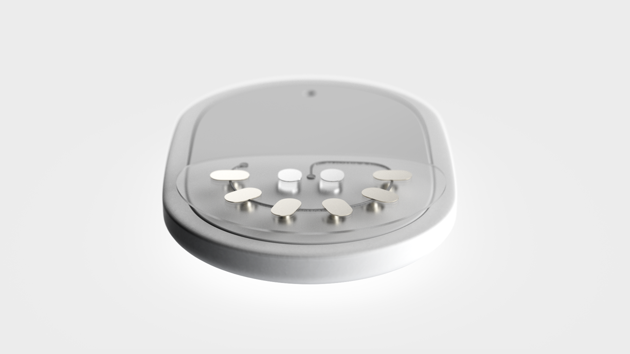
Two iontophoresis electrodes stimulate sweat glands, producing sweat that passes through six electrochemical sensors in a microfluidic channel.
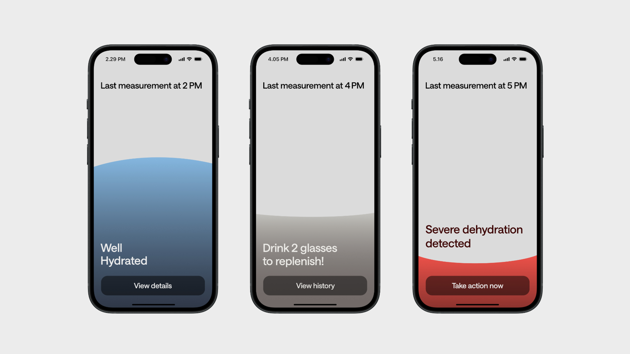
The user interface employs minimal graphical elements, using clear color indicators with actionable recommendations and detailed information available on demand.
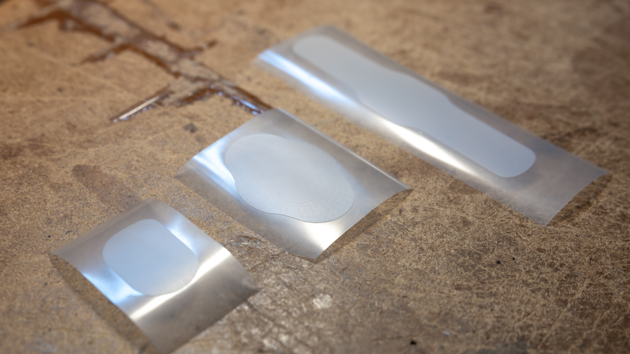
Adhesive foil prototypes, processed on a vinyl cutting machine, were used for concept validation and ergonomic shape assessment.
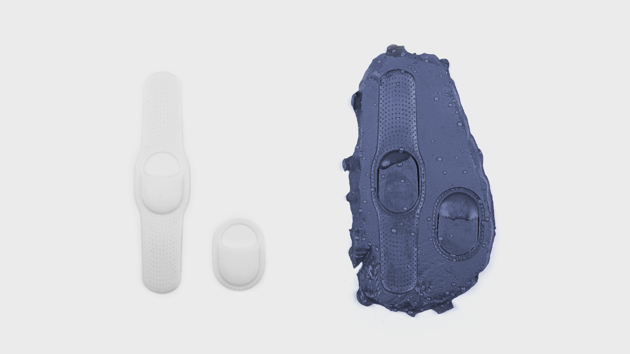
3D-printed positives of both patch designs were used to create the first silicone negative mold, which were used to produce the initial flexible silicone prototypes.

Material experimentation with SLA 3D prints and silicone molds.











